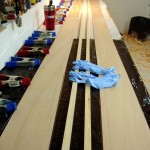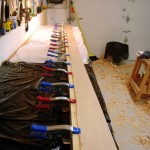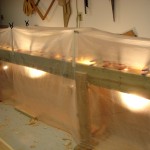Overnight temps have been gradually warming. The shop temperature reached epoxy’s almost minimum temperature yesterday. I’ve been waiting for this time because the next step in assembling the Mill Creek 13 canoe requires gluing the sheer clamps to the sheer planks. Sheer clamps are longitudinal framework members which strengthen the area where the top (sheer) plank joins the deck. Sheer clamps for this boat are 3/4 inch by 1/2 inch. Pieces were scarfed together to attain the needed length.
 There were two sorts of preparation, preparing to glue the parts together, and preparing a place to keep the assembly warm enough to cure.
There were two sorts of preparation, preparing to glue the parts together, and preparing a place to keep the assembly warm enough to cure.
A clamp is going to be glued to each plank. Then, each plank and clamp pair is going to be sandwiched into one assembly for clamping and curing. A strip of clear packing tape on the outer faces of the two planks prevents them from being glued to each other. Pencil lines on the inside faces of each plank ensure the clamp is being glued to the correct edge. These are double checked, and then triple checked at least twice again. All of my squeeze clamps are gathered up and laid out. A fresh pair of critically important nitrile gloves are donned and the epoxy mixed.
 SAFETY note: My loving spouse always tells me never to use absolute superlatives such as never and always, every and none. Yet, this is a case where they apply. EVERY thing I’ve read about epoxy says with certainty that EVERY person will become allergically sensitive to it, some with devastating results, and that the ONLY way to avoid such sensitivity is to NEVER let the stuff touch ANY part of your skin. So, these gloves, buy in bulk, are the minimum. Depending on how involved the operation, longer gloves and more protective clothing might be in order.
SAFETY note: My loving spouse always tells me never to use absolute superlatives such as never and always, every and none. Yet, this is a case where they apply. EVERY thing I’ve read about epoxy says with certainty that EVERY person will become allergically sensitive to it, some with devastating results, and that the ONLY way to avoid such sensitivity is to NEVER let the stuff touch ANY part of your skin. So, these gloves, buy in bulk, are the minimum. Depending on how involved the operation, longer gloves and more protective clothing might be in order.
Woodworkers talk of “glue-ups” being anxiety filled events. Not so with this epoxy. For this particular glue-up, a simple wood to wood join, I’m using some West System epoxy that’s left over from the previous build. It uses a slow hardener that provides 20-30 minutes of open time, more when the temperatures are cool. So, there was plenty of time to get the pieces in place, get the squeeze clamps on and make sure all the usual slipping and sliding ended up with the parts slid into the correct configuration.
 Now, let’s keep it reasonably warm while the epoxy cures. My cheap solution to that end consists of 5 clamp lamps with as many 100 watt bulbs, the real ones, not those wimpy curly things, and a couple of sheets of polyethylene drop cloths. The lamps are clamped to the bottom of the boat building bench, pointing upward. The plastic is draped over temporary slats that keep it off the bench, off the glued up parts, and off the lamps. This tent arrangement builds the temperature up to about 70 degrees, plenty sufficient for good curing.
Now, let’s keep it reasonably warm while the epoxy cures. My cheap solution to that end consists of 5 clamp lamps with as many 100 watt bulbs, the real ones, not those wimpy curly things, and a couple of sheets of polyethylene drop cloths. The lamps are clamped to the bottom of the boat building bench, pointing upward. The plastic is draped over temporary slats that keep it off the bench, off the glued up parts, and off the lamps. This tent arrangement builds the temperature up to about 70 degrees, plenty sufficient for good curing.
While it cures, it’s back to making lathe parts.
Bob, I’m with you 100% on the gloves. I’m reluctantly using epoxy to glue the planks on my boat to save some time, but I don’t like the stuff and am taking every precaution. Not the place to show how macho you are!